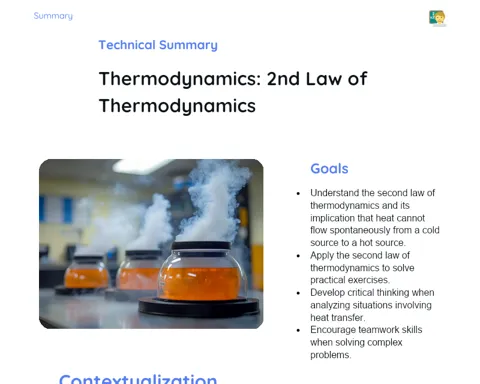Electricity: Parallel Resistors | Active Summary
Objectives
1. Master the concept of resistors in parallel and understand how to calculate the equivalent resistance using the appropriate formula.
2. Develop practical skills in assembling and analyzing electrical circuits with resistors in parallel, applying Ohm's Law.
3. Encourage critical thinking and the ability to solve practical problems involving resistors in parallel, preparing students for real-world applications in everyday situations.
Contextualization
Did you know that the way resistors are connected in a circuit can directly impact the performance of electronic devices we use every day? For example, in a sound system, the configuration of parallel resistors is crucial to ensure sound quality and distribution. This concept is not limited to physics laboratories but is fundamental in various technologies around us, from smartphones to security systems. Understanding resistors in parallel is understanding how to optimize and guarantee the efficiency of many electronic devices that enhance our daily life.
Important Topics
Parallel Resistors
Parallel resistors are a circuit configuration where two or more resistors are connected in such a way that one terminal of each resistor is connected to a common point and the other terminal is connected to another common point. This configuration is fundamental to evenly distribute the electric charge and ensure that the voltage applied is the same across each component of the circuit.
-
The voltage across each resistor in parallel is the same and equal to the total voltage applied to the circuit.
-
The equivalent resistance of parallel resistors is always less than the smallest individual resistance involved, which helps to reduce the total resistance of the circuit and increase the total current.
-
The formula for calculating the equivalent resistance (Req) in a parallel circuit is 1/Req = 1/R1 + 1/R2 + ... + 1/Rn, where R1, R2, ..., Rn are the values of the individual resistances.
Ohm's Law
Ohm's Law is a fundamental principle of electricity that relates current, voltage, and resistance in an electrical circuit. According to this law, the current (I) that flows through a conductor between two points is directly proportional to the voltage (V) and inversely proportional to the resistance (R) of the conductor, expressed by the formula V = IR.
-
Essential for understanding how differences in voltage and resistance affect current in a circuit.
-
Crucial for calculating the total or individual current in a parallel resistor circuit when applying the total voltage of the circuit and the equivalent resistance.
-
Helps in solving practical and theoretical problems in electronics, automation, and the development of electrical devices.
Electrical Circuits
Electrical circuits are interconnecting arrangements of electrical components, such as resistors, capacitors, inductors, and power sources, that form a closed path through which current can flow. Understanding circuits is crucial for effectively applying concepts such as parallel resistors.
-
Allows practical application of theoretical concepts of resistance and Ohm's Law in real situations involving the assembly and operation of electronic devices.
-
Circuit analysis helps identify issues such as overloads, short circuits, and energy inefficiencies.
-
Knowledge about circuits promotes innovation and the creation of technological solutions in various fields, from electrical engineering to computing.
Key Terms
-
Parallel Resistors: Components of a circuit connected such that all positive terminals are connected to a common point and all negative terminals to another, sharing the same voltage.
-
Ohm's Law: Relates current, voltage, and resistance in an electrical circuit through the formula V = IR, where V is the voltage, I is the current, and R is the resistance.
-
Equivalent Resistance: The total resistance value that replaces a set of resistors in parallel or in series in a circuit, affecting the voltage and current in it.
To Reflect
-
How can the configuration of parallel resistors impact energy consumption in household devices?
-
In what way does Ohm's Law help prevent electrical problems in residential and industrial circuits?
-
What is the importance of studying electrical circuits for the development of new technologies and environmental sustainability?
Important Conclusions
-
In this lesson, we deeply explored the concepts of parallel resistors, highlighting how the configuration of these components is essential for the efficient operation of various electronic devices.
-
We learned how to calculate the equivalent resistance in parallel circuits and how to apply Ohm's Law to determine the current and voltage at various points in a circuit.
-
We discussed practical applications of parallel resistors, from lighting systems to security devices, showing how physics is closely linked to our daily lives.
To Exercise Knowledge
Draw a circuit that includes at least three resistors in parallel and calculate the total resistance. Assemble a simple circuit with parallel resistors using a battery as a power source and measure the current with a multimeter. Create an infographic explaining how the configuration of parallel resistors is used in an electronic device of your choice, highlighting the importance of equivalent resistance.
Challenge
Project 'Efficient Home': I propose that you design a lighting system for a small house using LED bulbs connected in parallel. Calculate the total resistance and energy savings compared to an incandescent bulb system. Present your results in a brief presentation.
Study Tips
-
Review class notes and try to explain the equivalent resistance formula to a friend or family member. Teaching is a great way to learn!
-
Watch online videos about parallel electrical circuits to see more practical examples and experiments.
-
Practice more parallel circuit problems from different sources, such as textbooks or physics education websites. The more problems you solve, the more familiar you will become with the concept.



